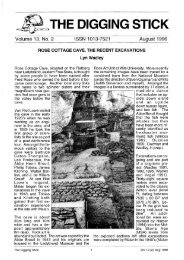The Digging Stick - The South African Archaeological Society
The Digging Stick - The South African Archaeological Society
The Digging Stick - The South African Archaeological Society
You also want an ePaper? Increase the reach of your titles
YUMPU automatically turns print PDFs into web optimized ePapers that Google loves.
Volume 4, No. 1<br />
April 1987<br />
Published by<br />
<strong>The</strong> <strong>South</strong> <strong>African</strong><br />
Archaeolog ical<br />
<strong>Society</strong><br />
Private Bag X4<br />
Leeusig<br />
8009<br />
<strong>South</strong> Africa<br />
Editor: Shirley-Ann Pager<br />
ISBN 0 620 05488 3<br />
This issue of <strong>The</strong> <strong>Digging</strong> <strong>Stick</strong> has an interesting variety of articles and<br />
again, as in our last issue, some contributions describing archaeological<br />
researches taking place in other countries. Our magazine is<br />
beginning to acquire an international aspect.<br />
Contributions for the September 1987 issue should please reach me by<br />
mid-August.<br />
Shirley-Ann Pager, Editor, P 0 Box 21083, Windhoek, 9000 SWAI<br />
Namibia.<br />
EXPERIMENTALARCHAEO-METALLURGY<br />
AND ARCHAEOLOGY AT MELLVILLE<br />
KOPPIES. A JOHANNESBURG<br />
NATURE RESERVE<br />
RH Steel<br />
It was a fortunate event when Professor R. J. Mason<br />
discovered the first remains of prehistoric people in the<br />
early days of the Melville Koppies Nature Reserve<br />
(Emmarentia. Johannesburg). This was followed by the<br />
discovery of the well-known Mellville Koppies smelting<br />
furnace on the upper slope of the hill (1963)", Shortly<br />
afterwards (1964) a second furnace was excavated by a<br />
group of members of the <strong>Archaeological</strong> <strong>Society</strong>. digging<br />
under the guidance of Professor Mason. <strong>The</strong>se early<br />
discoveries have been described by Professor Mason in a<br />
publication entitled 'Archaeology and Human Ecology of the<br />
Melville Koppies Nature Reserve' (1971). a booklet, which<br />
contains interesting papers on Stone Age artefacts.<br />
pottery. remains of settlements. bones and shells from a<br />
cave on the western part of the reserve as well as on the<br />
geology and ecology of the area. This booklet (Occasional<br />
Paper No. 6. Departent of Archaeology. University of the<br />
Witwatersrand) is now out of print. It should. however.<br />
be replaced by a publication describing the more recent<br />
researches - archaeological. archaeo-metallurgical.<br />
palaeobotanical and ecological which have been<br />
undertaken at Melville Koppies and other Nature Reserves<br />
of the greater Johannesburg region. Lack of funds<br />
unfortunately prevents this newest information from being<br />
publ fshed.<br />
A unique series of prehistoric-type furnace reconstructions at the<br />
Mellville Koppies testing ground, 1986.<br />
<strong>The</strong><br />
<strong>Digging</strong><br />
<strong>Stick</strong><br />
Investigations at Melville Koppies continue and I have<br />
excavated some Late Iron Age sites in the bush-covered<br />
central part of the eastern Koppie, a well-preserved hut<br />
floor and a walled settlement where many potsherds were<br />
found. A number of decorated sherds show that not less<br />
than a dozen pottery types and patterns are represented<br />
here.<br />
During the last winter (July-August 1986) a team of<br />
members of the <strong>Archaeological</strong> Research Unit, Department of<br />
Metallurgy (Dr H. Friede. Dr A. A. Heijja and Mr R. Steel)<br />
constructed and worked a testing ground for Iron Age metal<br />
smelting furnaces on a plateau next to the upper Iron Age<br />
furnace site 7/63. <strong>The</strong>se models of seven different types<br />
of furnaces. based on excavated Iron Age furnaces in the<br />
Western and Central Transvaal. were constructed using<br />
local material and traditional methods employed by the<br />
ancient smelters.<br />
One model was built to the pattern of the excavated<br />
Late Iron Age Melville Koppies furnace. another to that of<br />
a Western Transvaal (Kaditshwene) furnace. Three models<br />
were replicas of furnaces excavated recently by Professor<br />
Mason. A small pit furnace from Bultfontein. a copper<br />
smelting furnace from Ifafi (both in the Hartbeespoort -Dam<br />
area) and a trench furnace from Lone Hill. Smelting<br />
experiments were carried out in each of these<br />
reconstructed furnaces. A forge furnace was used for<br />
resmelting and shaping the metals produced. <strong>The</strong> hard work<br />
of pumping air into the furnace fire with qoatskin bellows<br />
was done by <strong>African</strong>s.<br />
<strong>The</strong> experiments gave valuable information on many<br />
aspects of the lost art of traditional <strong>African</strong> smelting<br />
technology: on the blowing and firing of the furnace.<br />
control of air supply. the various stages and time of the<br />
process, di scharge, resmel ting and forging of iron, the<br />
efficiency of the various furnaces and the types of ore<br />
and charcoal. Temperatures and air flow rates in the<br />
furnaces were measured by special instruments. Studies of<br />
economics of furnaces. labour and material were conducted<br />
and the slags and metal produced were analysed. <strong>The</strong><br />
results of all this research will be published at a later<br />
stage.<br />
Melville Koppies Nature Reserve has seen many thousands<br />
of visitors and demonstrations of the smelting process for<br />
the publ ic were started in 1979. <strong>The</strong> most recent<br />
demonstration, in September 1986, was given for the<br />
benefit of a large group of members of the S A<br />
<strong>Archaeological</strong> <strong>Society</strong>.<br />
<strong>Archaeological</strong> Research Unit. University of the<br />
Witwdtersrand, 2050 Wits<br />
HANDED NESS PRESENT AND PAST<br />
A R Willcox<br />
In THE DIGGING STICK 1:3. 1984, Townley Johnson calles<br />
attention to the question of handedness in rock artists.<br />
In his experiment 7% of the children were revealed as<br />
left-handed and all of them drew their elephant facing to<br />
the right, whereas the 93% right-handers portrayed it<br />
facing left. It is remarkable that out of 100 students<br />
there were no exceptions to the rule.<br />
Johnson cites a study in Germany and <strong>South</strong> Africa by<br />
Arnold Schecker which indicates that 6% of the population






